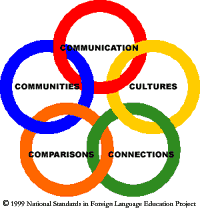Modes of Communication
Models Informing Assessment

The Five Cs of the World-Readiness Standards
The five goal areas of the World-Readiness Standards—Communication, Cultures, Connections, Comparisons, and Communities—represent goals to be included in the instruction of all world languages. The goals are interconnected signifying that no goal should be addressed in isolation. Although the five Cs appear equally significant in the Standards' symbol of interlocking rings, it is clear that the Communication goal is the heart of the Standards as it is the ring at the top center of the graphic. Learning scenarios, such as those included in World-Readiness Standards for Learning Languages, provide examples, lessons, and units that interweave the five C's in instructional contexts.
Four-Skills Model
Language teachers are generally familiar with a four-skills model of communication, in which reading, writing, listening, and speaking proficiencies are assessed individually. A four-skills approach will continue to be a useful model for assessment, as it is often necessary to avoid confounding performance on one dimension, such as listening, with skill in another area, such as reading. Assessing skills individually is desirable in situations where learners have acquired language in a variety of ways, and thus may not share common pathways to proficiency—often the case with adults. Evaluation criteria, such as those of the ACTFL Proficiency Guidelines, describe what individuals can do with language in terms of speaking, writing, listening, and reading. There are five major levels of proficiency for each skill: Distinguished, Superior, Advanced, Intermediate, and Novice.
